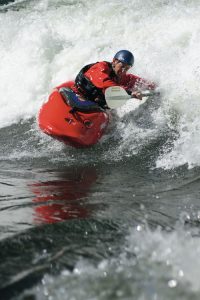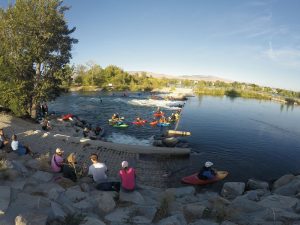Twenty years ago, Boise kayaker Paul Collins had a dream to build a small wave on the Boise River where kayakers could safely practice and play. That whimsy turned into a $25 million collection of facilities that includes 66 acres of flat-water paddling, waterfront park space and a state-of-the-art, in-river whitewater park that’s still growing.
“I didn’t imagine what we have, but I dreamt about it,” said Collins, an orthopedic surgeon based in Boise. “I couldn’t’ tell you the specific size, depth, how much concrete or where the waves would be. But I had a dream that we would have a place to play, and we do.”
Collins continues to work as part of a group called Friends of the Park, which raises money for the still-expanding riverside facilities in Boise’s West End. Although he and a handful of others first introduced the notion of a river park to the community, it has grown far beyond their original vision. Major financial stakeholders now also include the J.A. and Kathryn Albertson Family Foundation, J.R. Simplot Foundation and City of Boise, each having contributed millions to transform a neglected part of the city into what may well be the nation’s premier outdoor aquatics recreation facility.

Stan Kolby co-owns Idaho River Sports, a store that sells and rents paddling gear out of the renovated Consolidated Concrete offices between Whitewater Park Boulevard and Quinn’s Pond. Having bought the old concrete plant headquarters in 2004, six years before a shovel ever touched the dirt, he’s had front-row seats to the extensive, years-long redevelopment.
“Last summer absolutely blew me away,” Kolby said, describing the first summer after the north bank of Quinn’s Pond was redeveloped to include sand and picnic facilities. “I thought I’d moved to the beach in Florida. There were umbrellas and pop-up shelters and towels over every square inch of sand on that beach. And the amount of people using it—there were 400 people a day out there.”
What will eventually present to visitors as a seamless single park with four ponds, acres of green space and four surf and kayak waves actually comprises several distinct phases, land ownership patterns and funding sources. It started in 2012 with the grand opening of Phase I of the J.A. and Kathryn Albertson Family Foundation Boise Whitewater Park, a river-wide dam with adjustable flashboards that can change the way its two waves look, feel and surf.
“Nobody had really seen anything like that before,” said Micah Kneidl, a lifelong Treasure Valley resident who’s been whitewater kayaking for 20 years. “To have a wave shaper and a river-wide feature that was at least two separate features based on the walls and gates—it was revolutionary and advanced.”
Kayakers immediately began testing their mettle on the waves, but one of the unexpected outcomes was an incredible surge in the number of surfers riding the wave on traditional surfboards. For the last several years, the city has adjusted the wave on a predictable schedule for both uses.
Work then began in February 2015 on Esther Simplot Park, which borders Quinn’s Pond and encapsulates newly built Esther’s Pond. The beachfront at Quinn’s was unveiled a year ago, but the entire grand opening for the $12 million park with 23 acres of water was held last November.

Kneidl said he took his 6-year-old son to the park’s grand opening and “was genuinely blown away.”
“This summer I see myself packing a sack lunch, going down there with my son, taking our kayaks, maybe a paddle board, and we can spend most of a day paddling in the flat water, making the short walk over to the wave shaper where he can watch me play on the wave,” Kneidl said. “When I was younger I used to think of this just as a whitewater park. I’ve grown up a lot since then, and this is so much more than a whitewater park. It’s a package, a great way of enjoying water-based recreation in an urban part of Boise.”
The city of Boise is now preparing for Phase II of the whitewater park, which is being designed by world-renowned kayaker Scott Shipley. Shipley’s company, S2O, specializes in whitewater recreation facilities and is planning three additional whitewater wave features that will be built downstream from the existing wave shaper.
Boise Department of Parks and Recreation Director Doug Holloway said the plan is to start construction next fall and finish in-river work before the ensuing irrigation season starts. The following year will include ongoing work to rehabilitate the riverbank and install park amenities for total park completion by the spring of 2019. From the time the first dirt was moved in 2011, it will be an eight-year, $25 million process.
“It’s a game-changing, transformational amenity for the city of Boise,” Holloway said. “We’re about providing healthy, wholesome activities for families in our community, and this really almost rises to the top of what we can provide to the community at no cost. It’s healthy, it’s safe, it’s got economic impact.”
Holloway said the city’s original focus was to enhance its portfolio or recreational offerings, but the park has already become an economic asset for the city’s West End and parts of Garden City that border the river. Paddling shops like Idaho River Sports and Corridor Paddle Shop moved to the area, as did watering holes like the Yardarm, Telaya Wine Co. and Sandbar Patio Bar and Grill. More are likely to follow.
“The goal was to create a great recreation amenity for our citizens,” Holloway said. “When we were doing that we realized we also created an economic impact for the city. And then we realized there’s not really anything like this in the country.”
It’s a pretty big statement to declare anything best of class in the country, but Kneidl agreed with Holloway’s assessment.
“I’m pretty well versed in the whitewater world and have seen and read about a lot of other parks,” he said. “As of today, even without the other phases being constructed, it might be the best one in the world.”
Things have come a long way since Paul Collins and the Friends of the Park first advocated for a surf wave in the City of Trees. Boise has grown and changed, but Collins still loves the smooth, visceral experience of surfing a wave in his kayak. And that’s really how it all started.
“I still love to boat,” he said. “You get out there. You’re on the wave. You can see the water racing under you. You can feel the pulses and push and pull of the river. It just soothes you and calms you. That’s the kind of feel I want other people to develop.”
